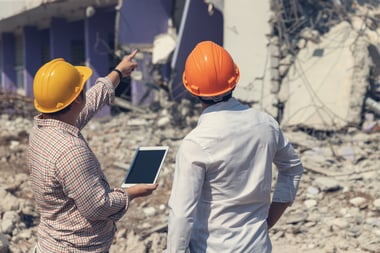
The world of building construction and safety was rocked a month ago with the collapse of the condominium in Surfside, Florida. A forty-year-old building is not old in comparison to many other structures around the world. But, when taking a closer look, little is known to the naked eye about what lies beneath and within a building, structurally. When it comes to building safety and fire and life safety, that’s something fire and life safety companies can help control and mitigate any issues.
All buildings are under stress. The weight of the building’s structural elements as well as everything inside all play a role in any structural faults that may exist. There are many building construction and fire safety codes outlined in NFPA 5000: Building Construction and Safety Code that must be met before, during and after construction.
An experienced fire and life safety company will ensure NFPA 5000 code accuracy during inspections to mitigate any sort of incident that may be at risk to the building and those items inside. A fire and life safety company has a job to understand the importance of the NFPA 5000, including some of the key features: structural loads, their forces and the associated hazards as described in the structures one is inspecting and/or maintaining.
What is the NFPA 5000?
NFPA 5000 code provides requirements for those construction, protection, and occupancy features necessary to safeguard life, health, property, and public welfare and minimize injuries. It describes loads and the forces on them, and they are defined and given value as they relate to design requirements and safety.
Load combinations are calculated using various equations that can accurately define the load requirements for a wide variety of structure features. As a fire and life safety company, it’s important to know the load combinations as it can determine hazard levels and allows one to anticipate the consequences of non-regulatory construction.
Building and Occupancy Hazard Levels
As described in NFPA 5000 and NFPA 101 and local authority having jurisdiction (AHJs), all buildings and their occupancy classifications are defined by requirements. These requirements are categorized by hazard levels:
-
Level I: Represents a low hazard to human life in the event of failure. This can include agricultural facilities, storage buildings, and temporary structures.
-
Level II: Considered typical structures, such as residential and commercial buildings, by construction standards and would produce light hazard to occupancy and contents. This level can change if there’s modifications in use, content within, or any remodeling.
-
Level III: Represents a substantial hazard to human life in the event of a failure or deficiency. Some examples are building with more than 5,000 occupants, universities, or prisons.
-
Level IV: This level represents essential structures that include safety (fire stations), national security, emergency shelters, or aviation. Essential power and water are also included in this level.
Building Structural Loads
Buildings are designed and built to carry heavy loads under the most extreme circumstances, but when those buildings and loads are tested, the worst could happen. Structural loads can be described in three categories: dead, impact, and live.
-
Dead: Dead loads are forces that are considered constant and can be under tension, such as walls, roofs, parking garages. These loads can also contain items that one wouldn’t think of as structural like risers, sprinkler systems, and electrical boxes. This load accounts for the most structural weight and can have extreme consequences.
-
Impact: Impact loads are associated with the moving of heavy machines, vehicles or stored merchandize inside a structure. An example would be the random movement of a construction crane onsite. This random movement can cause a collapse without any structural indicators.
-
Live: Live loads include people, furniture, or weather. During emergencies or natural disasters, these can become critical as many pieces are moving within and outside the structure. For example, people evacuating during a hurricane.
Forces
Forces on a building can play a major role in its structural integrity. Fire and life safety officials look at forces in three ways: concentrated, linear, and distributed.
-
Concentrated: This is a force that acts over a small area and is concentrated to that single location. It could initiate a complete collapse depending on the location (ex: low bearing beam or beams stacked on top of one another).
-
Linear: This force focuses on loads that are along a line where a fire or disaster could travel along that particular line path resulting in a full or partial collapse.
-
Distributed: This force happens when a hurricane or heavy load is carried over a large area and not specific to a small location; it’s distributed across the structure.
Structural Stress
Everyone knows that when stress is applied to something, it’s bound to give way over time. The stresses on buildings are no different. There are three types of stresses: compression, tension, and shear.
-
Compression: This stress refers to a direct force on a wall or column. It’s most dangerous where a building or room is weakest, such as a low bearing wall separating two rooms.
-
Tension: This one is pretty self-explanatory. Tension stress refers one structural piece pulling on another. This stress can often be seen in new construction where walls have been places but there’s little to no structural framing to be seen.
-
Shear: Shear stress is a stress forced on a horizontal structure that connects two vertical structures. Weight and shifting significantly contribute to the failure of this type of stress.
Building safety is on a lot of people’s minds right now. A building’s age, location, development, and materials play a role in determining a building’s risk. While mother nature is out of our hands, if not properly inspected and maintained, these factors can contribute to a potential emergency or collapse.
For buildings owners, managers, and fire and life safety professionals, it’s critical to understand these topics mentioned above. In the event of an emergency that is non-preventable, this information can play a role in rescue operations.
While no one expects a collapse to happen, it’s important to be prepared and take the necessary steps to prevent one. A preferred fire and life safety professional can work with local AHJs and fire marshals to determine any deficiencies and rectify the situations, so everything is up to code and addressed in an appropriate timeframe.




